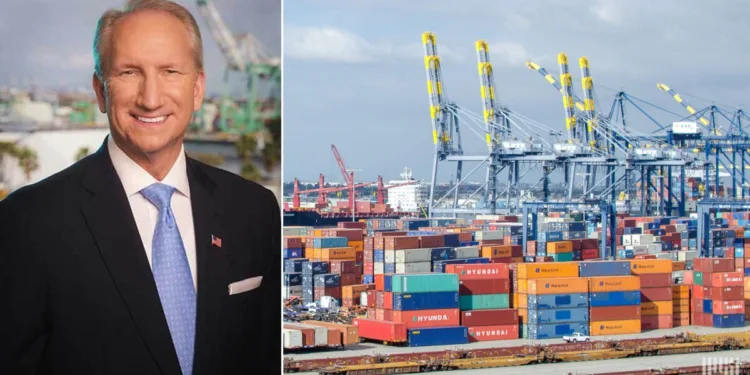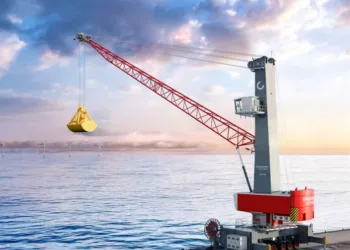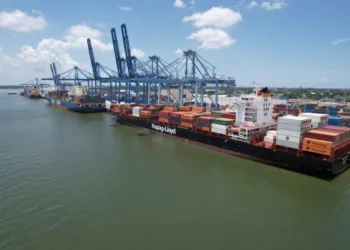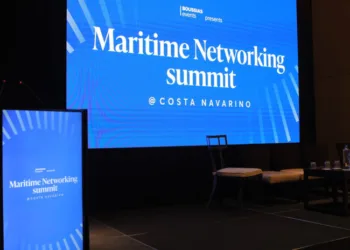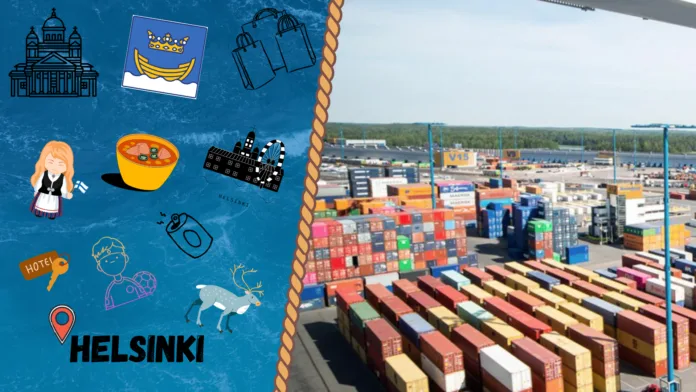While the global supply chain seemed whipsawed on a daily basis in 2024, one thing remained constant: a veritable tsunami of ocean containers moving through the Port of Los Angeles.
The busiest U.S. maritime trade hub moved 10.3 million container units in 2024, a record 1.7 million TEUs or nearly 20% higher than a year ago.
“That is our second-best year in the 117-year history of the Port of Los Angeles,” said Executive Director Gene Seroka, who spoke at the annual State of the Port event Thursday, “and nearly a 20% increase in volume over 2023. In fact, we moved 1.7 million more TEUs than last year, which is the largest incremental gain we’ve ever seen.”
Total volume finished short of the record 10,677,610 TEUs handled in 2021.
Total traffic in December, usually a weaker month following the runup of holiday merchandise, was 921,617 TEUs, up 24% year over year (y/y). Loaded imports totaled 460,916 TEUs, up 26%, while loaded exports totaled 110,484 TEUs, off 9%.
Empties, a pre-cursor of import flows, was 350,218 TEUs, ahead 37% from December, 2023.
“That kind of traffic is driven by a lot of factors,” said Seroka, entering his 11th year at the port. “A strong U.S. economy with robust imports and exports. The best labor force — bar none — in the world on the docks and on the roads. Significant investments by our two great western railroads, Union Pacific (NYSE: UNI) and BNSF, to efficiently accommodate increased cargo in and out of the San Pedro Bay.”
Coming off a near-record year, LA still has room to grow: Seroka in a media briefing this past fall said the port was operating at 80% capacity.
Seroka said cargo flows continue to be aided by data improvements as part of the Port Optimizer, launched in 2017, and the first phase of a Universal Truck Appointment System launched in 2024.
“This system gives drivers a single user interface to schedule appointments at our terminals, improving the workflow and lives of our 20,000 truckers,” Seroka said. “It was introduced just eight weeks ago, and we’re already seeing positive results.
As part of an $8 million dollar grant from the Governor’s Office of Business and Economic Development, the port is developing Phase 2 of the system to integrate appointments systems at both Los Angeles and neighboring Port of Long Beach.
“Leveraging real-time tracking data from the Port Optimizer, our customers will enjoy an even simpler and more seamless experience,” Seroka said.
There’s a direct correlation between speed of goods to market and workforce expansion, he said, “because every four containers we move creates a job, and over the last 10 years, longshore registration has increased by 27%.”
That kind of continuity served LA well over the past 12 months, when labor turmoil disrupted port operations from Texas to Boston, and along both coasts in Canada.
An on-dock rail project completed in 2024 at APM Terminal’s Pier 400 is expected to improve efficiency and boost container volumes across a wider range of inland locations.
Fenix Marine Services, a subsidiary of France’s CMA CGM, is breaking ground on a similar project at Pier 300. Seroka said rail expansion will enhance capacity for future growth, enabling the port and Fenix to compete for more cargo.
Infrastructure projects in 2024 were helped by a record $60 million in federal money from the U.S. Army Corps of Engineers’ Harbor Maintenance Trust Fund, which Seroka termed “a fair amount” more than a decade in the making.
Import taxes fund waterway maintenance projects and ports contribute about half the money in the fund but only see about 3% in return. Seroka credited recently retired Rep. Grace Napolitano and others who started advocating for an equitable distribution of those funds.
More broadly, Seroka said geopolitics presents a “significant” challenge both to the port and the maritime industry. In 2024, the gateway had to adapt to change from attacks on Red Sea shipping, drought conditions in the Panama Canal and labor issues on the East and Gulf coasts.
“In Washington, the new administration is talking about more tariffs and trade constraints. This post-globalization era is creating new headwinds that we must navigate.
“Now more than ever, ports, shipping lines, terminal operators, our workforce, communities and all other links in the supply chain must work together,” he said.
In May, the port opened the $16 million Maintenance and Repair Training Center on Terminal Island with the cooperation of the International Longshore and Warehouse Union and Pacific Maritime Association in an effort to retrain and upskill ILWU workers.
The port is also developing a Goods Movement Training Facility, the only workforce training center in the United States dedicated to goods movement.
Eyeing a future workforce, the port plans to expand its collaboration in advancing clean technology with the University of California at Los Angeles (UCLA), as well as a partnership with the California Community College system, with 2 million students at 116 schools — the largest higher education system in the country.
“Our aim is to equip these students with the education and skills needed for decarbonization and environmental stewardship,” Seroka said. “This partnership will keep local colleges updated on emerging technologies and prepare students for evolving job opportunities in our industry.”
Seroka said the port’s greenhouse emissions have dropped 24% since 2005, while TEUs and overall business has increased by 15%.
“This means, we are now down to the last 9% of diesel particulate matter and the last 2% of sulfur oxides from anything with an engine that moves cargo through our gateway.
“To put all this in perspective, these reductions are the equivalent of taking nearly 5-and-a-half million cars off the road.”
The port, meanwhile, is aiming for zero emissions.
The Clean Truck Program counts nearly 500 ZE trucks operating at LA-Long Beach, along with dockside tractors, top handlers and other equipment.
Over the last three years, the port complex has received nearly a billion dollars in federal and state funding, led by a $412 million EPA grant announced in 2024 for ZE equipment and terminal upgrades. With more than $230 million in matching funds from the port and terminal operators, total investment will exceed $640 million, the hub plans to deploy 250 ZE trucks and replace dockside diesel equipment with 424 ZE units, along with 300 charging stations.
Seroka said the port is working on securing funding to help Union Pacific purchase and develop a new zero-emissions locomotive for operations within the port.
At the same time, the Hydrogen Hub project is seeking $100 million for the San Pedro Bay ports through a grant from the U.S. Department of Energy. In May 2024, Yusen Terminals powered up the world’s first hydrogen-fueled rubber-tired gantry crane. Fenix Marine Services, in collaboration with Toyota, is testing a retro-fit hydrogen-powered top handler that can operate for 20 hours on a single tank of fuel.
Also, Yusen Terminals recently deployed five Taylor electric top handlers, and Everport is running two electric top handlers as part of a $8 million Advanced Cargo-Handling Demonstration Project.
“These projects not only transform our port; they also set a global standard, proving that economic growth and environmental stewardship can go hand in hand,” said Seroka. “At this point, every container terminal either has ZE equipment in use, or is actively planning for future-ready fleets.
To ramp up electrical capacity, the port has teamed with the Los Angeles Department of Water and Power on a $500 million upgrade to scale up battery electric equipment and provide reliable shore power.
“We must expand our infrastructure to accommodate additional electric cargo handling equipment, EV charging stations, and overall operations in order to meet our zero-emissions targets,” Seroka said.
The port also advanced maritime initiatives with eight different ports in China, Singapore, Japan and Vietnam to develop Green Shipping Corridors aimed at decarbonizing vessel operations.
“Collaborations like these will demonstrate the safety and feasibility of deploying the world’s first zero-carbon container ship by 2030,” Seroka said, adding the port in 2024 hosted the first U.S. call of the Alette Maersk, the first-ever green container vessel capable of running on carbon neutral e-methanol fuel.
Find more articles by Stuart Chirls here.
Related coverage:
Red Sea now a ‘case-by-case basis’ for CMA CGM
US says China pressed unfair advantages to dominate shipping, shipbuilding
Sola to head Federal Maritime Commission
The post Los Angeles, the busiest US container port, plans even bigger future appeared first on FreightWaves.



